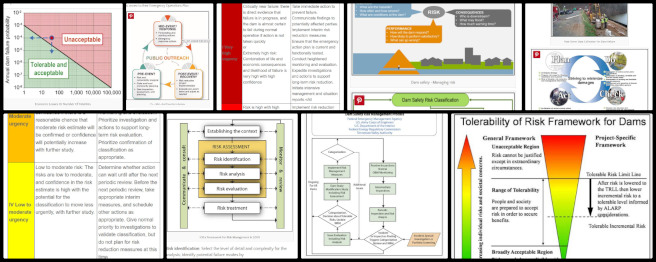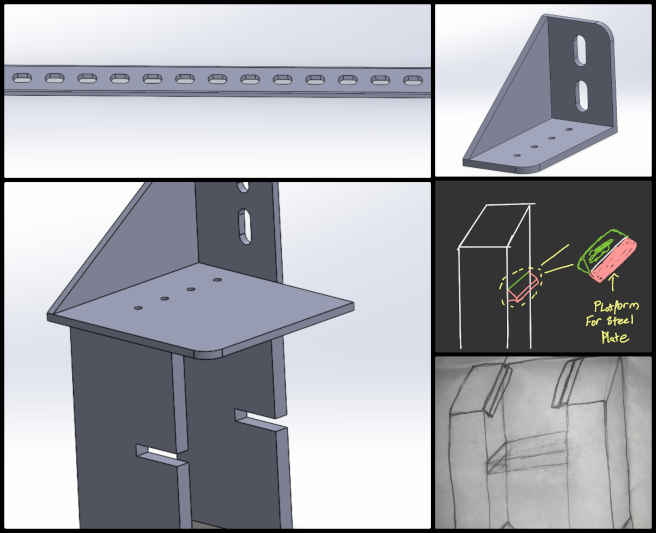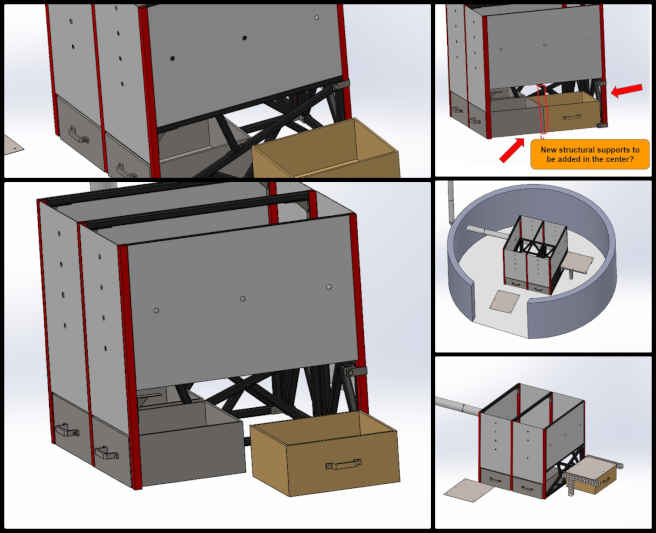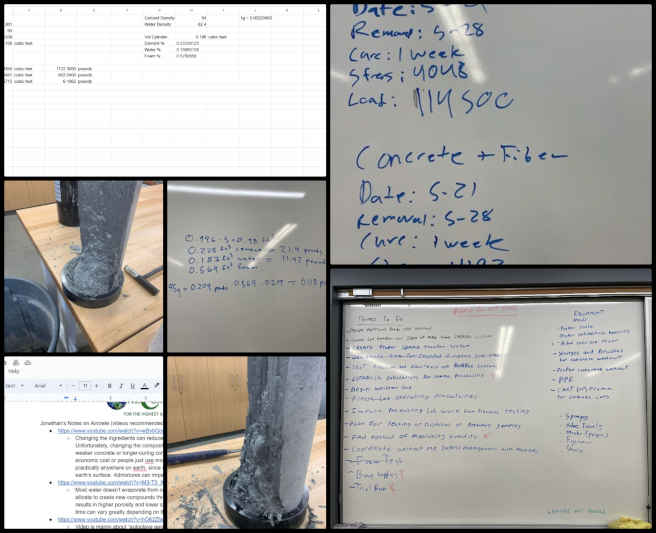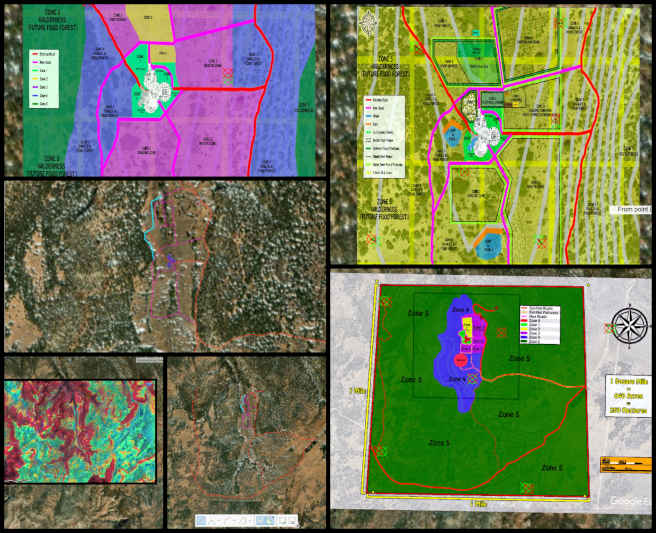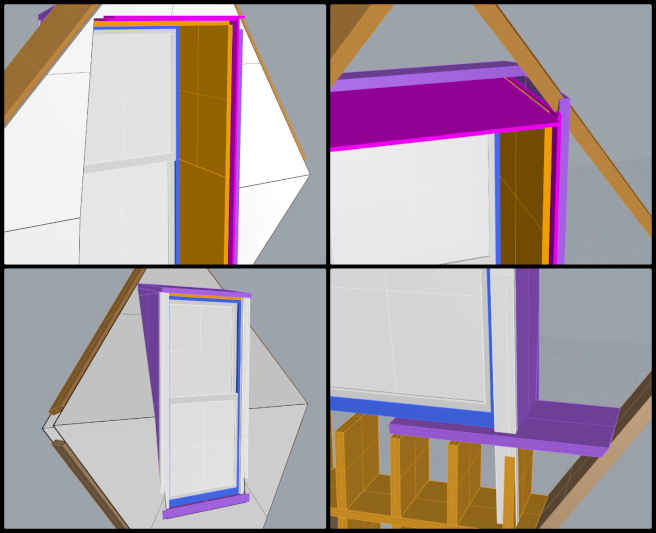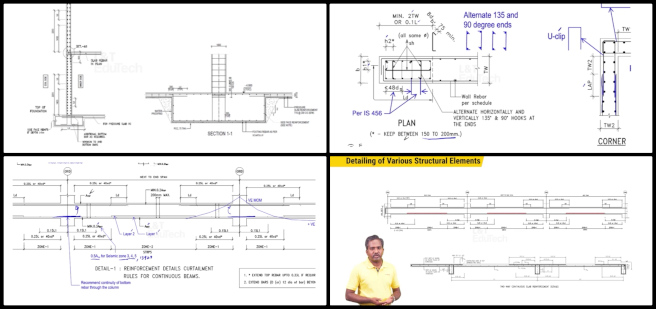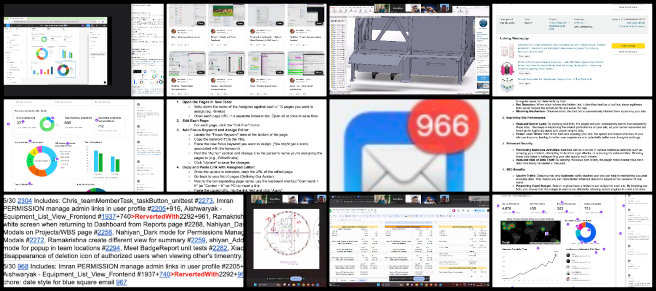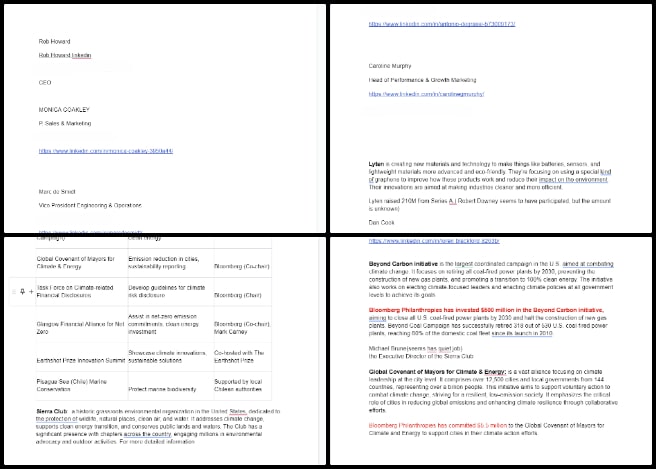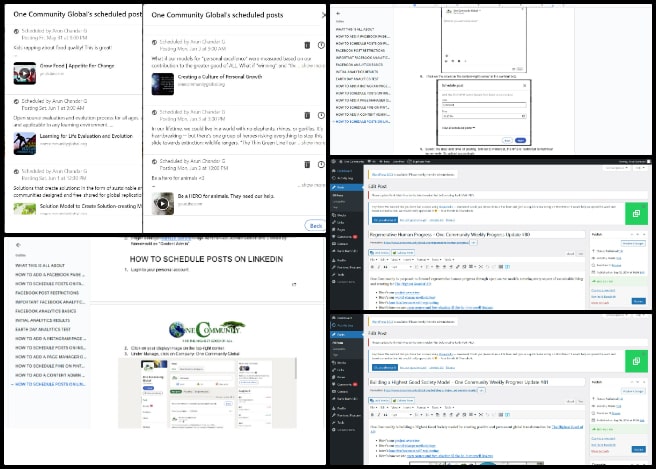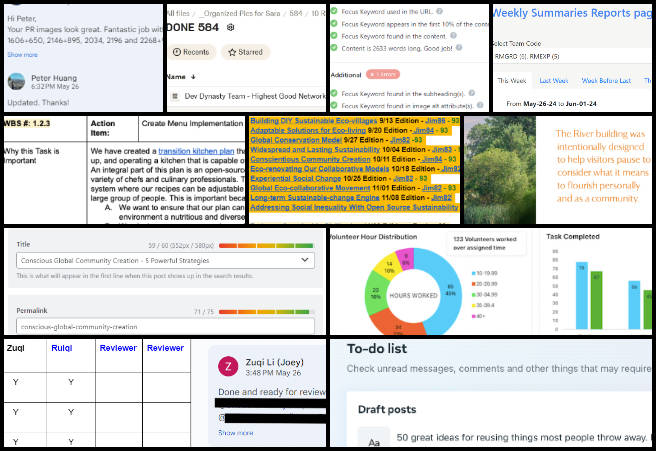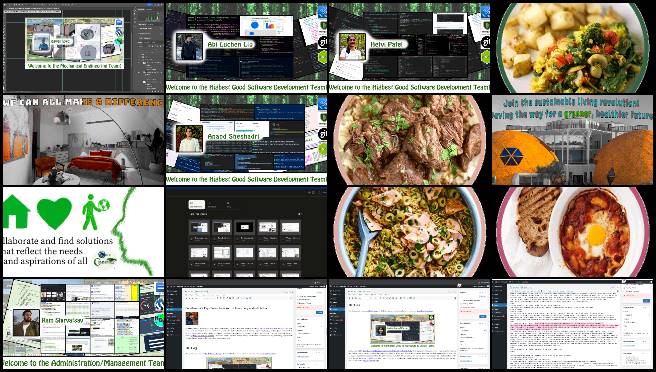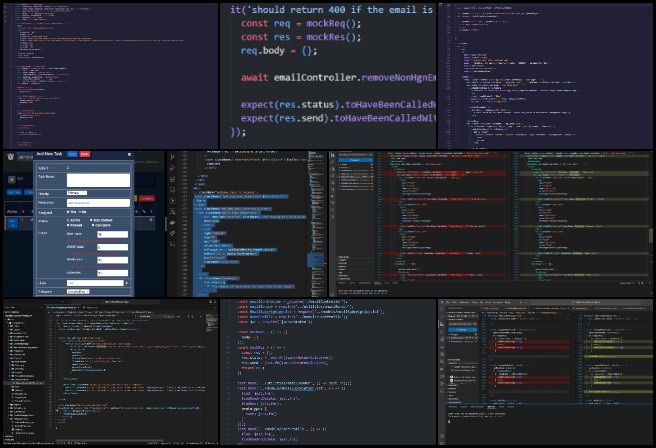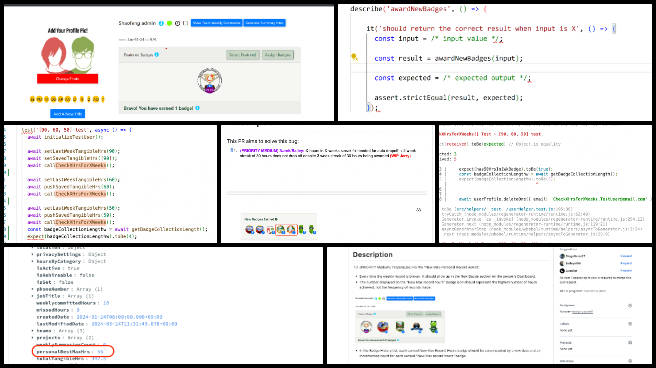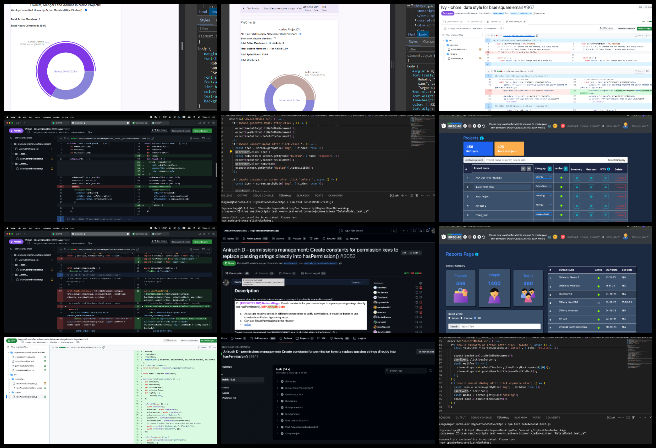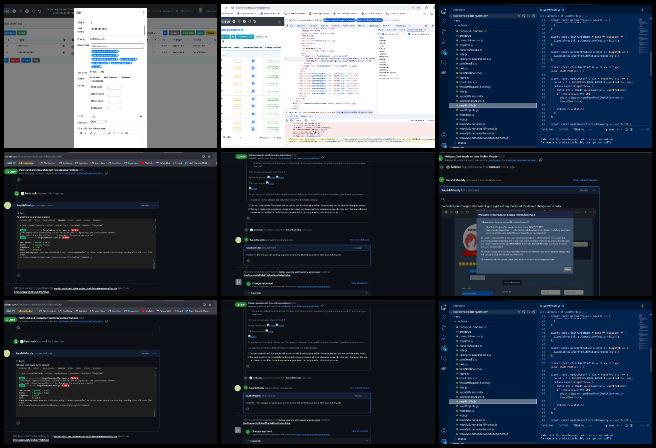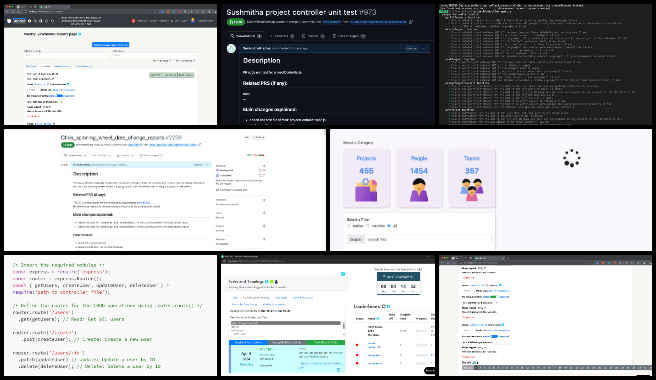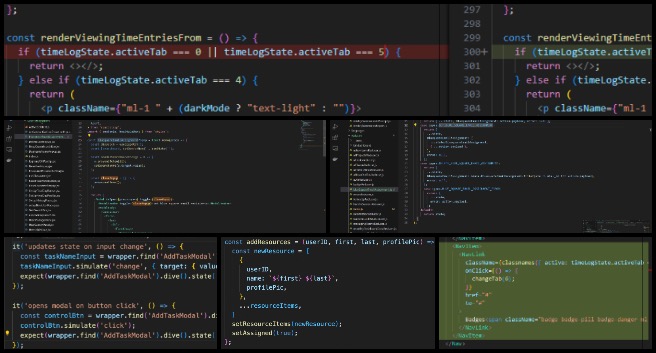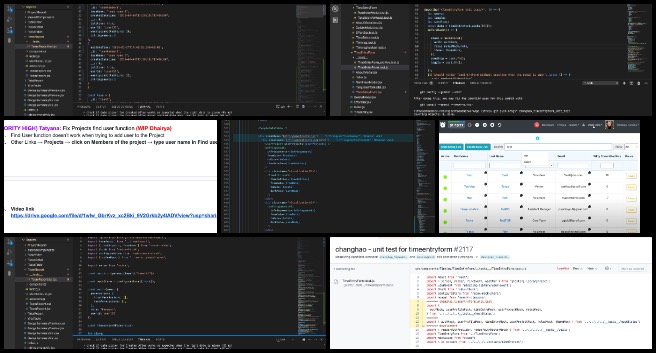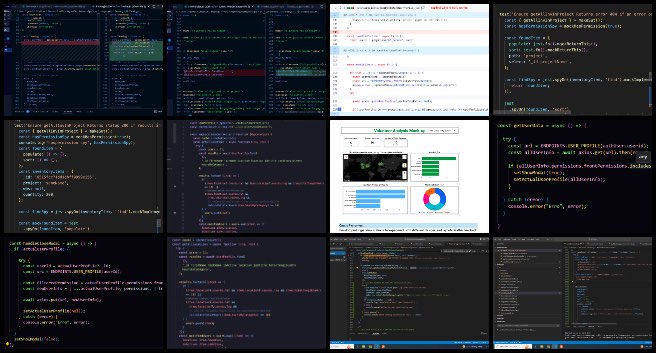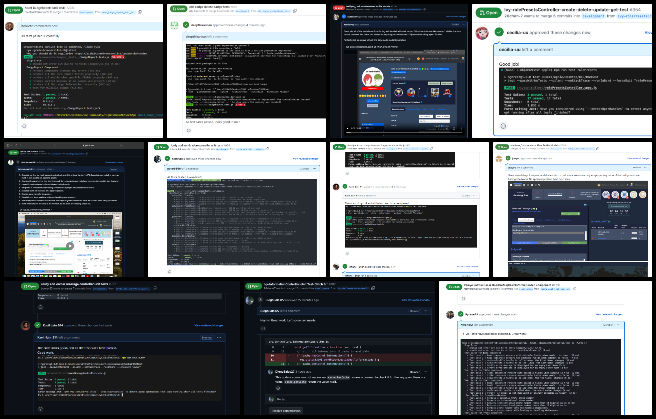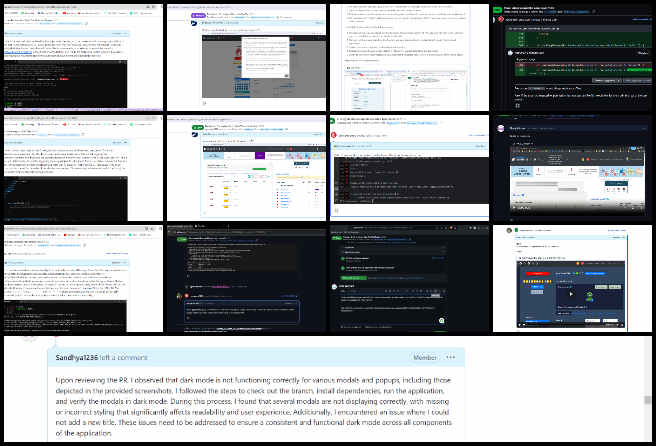Applying Cooperative Human Relationships – One Community Weekly Progress Update #585
Posted on June 3, 2024 by One Community Hs
One Community is applying cooperative human relationships to foster sustainable approaches to food, energy, housing, education, economics, and social architecture, and more. Our all-volunteer team is dedicated to creating a model that becomes self-replicating, forming a global collaboration of teacher/demonstration hubs. We’re doing this for “The Highest Good of All” by creating everything so it is open source and free-shared. Join us in evolving sustainability, regenerating our planet, and creating a world that works for everyone.
- Here’s our project overview
- Here’s our world-change methodology
- Here’s how this becomes self-replicating
- Here’s how we are open source and free-sharing all the do-it-yourself designs
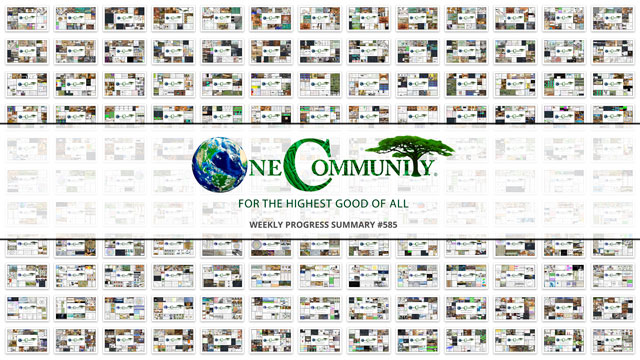
OUR MAIN OPEN SOURCE HUBS
Click on each icon to be taken to the corresponding Highest Good hub page.
One Community’s physical location will forward this movement for applying cooperative human relationships as the first of many self-replicating teacher/demonstration communities, villages, and cities to be built around the world. This is the June 3rd, 2024 edition (#585) of our weekly progress update detailing our team’s development and accomplishments:
Applying Cooperative Human Relationships
One Community Progress Update #585
DONATE | COLLABORATE | HELP WITH LARGE-SCALE FUNDING
CLICK HERE IF YOU’D LIKE TO RECEIVE AN EMAIL EACH WEEK WHEN WE RELEASE A NEW UPDATE
YOU CAN ALSO JOIN US THROUGH SOCIAL MEDIA
ONE COMMUNITY WEEKLY UPDATE DETAILS
HIGHEST GOOD HOUSING PROGRESS
 One Community is applying cooperative human relationships through Highest Good housing that is artistic and beautiful, more affordable, more space efficient, lasts longer, DIY buildable, and constructed with healthy and sustainable materials:
One Community is applying cooperative human relationships through Highest Good housing that is artistic and beautiful, more affordable, more space efficient, lasts longer, DIY buildable, and constructed with healthy and sustainable materials:
- Learn about: Our Upcoming Crowdfunding Campaign
- Learn about the different village models designed for applying cooperative human relationships: 7 Sustainable Village Models
- Visit the open source portals for the first two: Earthbag Village OS Hub | Straw Bale Village OS Hub
This week, Charles Gooley (Web Designer) focused on two pages: The Earthbag Village Tools and Equipmentent and Open Source DIY Earth Dam Design & Construction for Water Retention, Pond & Lake Creation. On the Earthbag Village Tools and Equipment page, he alphabetized the list of tools and equipment and added anchor links to each item on the list, both for the first and second lists. Additionally, he integrated these anchor links into the tool and equipment descriptions. On the Open Source DIY Earth Dam Design & Construction for Water Retention, Pond & Lake Creation page, he incorporated content from the provided Google Doc, including a section on Dam Break Risk Assessment. Earth constructions like both of these are an important part of applying cooperative human relationships with One Community’s open source plans. See his work in the collage below.
Joseph Osayande (Mechanical Engineer) continued helping develop the Vermiculture Toilet designs. This week, the coefficient of rolling resistance on concrete based on the weight of the drawer was determined. Research was done on various methods for moving the drawer onto a platform capable of withstanding its weight and transporting it over a distance, as well as ways to empty the drawer and the potential use of latches for a foldable side. A stand for the winch and holder was also considered. New design ideas for the structure were sketched to address flaws in the old design, and a quick CAD model was created to visualize the proposed improvements. The vermiculture toilets and other sustainable human waste processing technologies form the basis of One Community’s open source model for applying cooperative human relationships. See below for some of the pictures related to this work.
Rizwan Syed (Mechanical Engineer) also continued helping develop the Vermiculture Toilet designs. This week, Rizwan concentrated on the design of reinforcement structures for the vermiculture chamber, with particular attention to the assembly and disassembly of sub-components within the eco-toilets. He developed preliminary CAD models in SolidWorks, focusing on C-channel unistrut reinforcements that allow for lateral movement of removable drawers along the chamber assembly. Adjustments were made to the size of the removable containers to ensure they fit seamlessly with the unistrut reinforcements and could be easily inserted from the front. Rizwan also reviewed AutoCAD plans of the Earthbag Village to check for potential interference or collisions between the removable drawers, reinforcements, and the overall structure of the village. In addition, he began compiling a list of necessary hardware components, including rubber plugs, bolts, and nuts, essential for the assembly of the drawers and barrier sheets in the vermiculture system. The vermiculture toilets and other sustainable human waste processing technologies form the basis of One Community’s open source model for applying cooperative human relationships. Here are a few photos showing examples of his work.
AIRCRETE TEAM
The Aircrete Testing Team’s summary, covering their work on Aircrete Compression Testing was managed by John Sullivan (CBU Chemical Engineering Student) and includes Jonathan Crago (Civil Engineering Student), Preston Thompson (Civil Engineering Student), and Tom Sheppard. This week, Jonathan worked with his team to perform compression testing on the remaining concrete test cylinders and assisted in organizing the concrete testing room. He and his group recalculated the correct mixing ratios and compiled a list of equipment to be purchased. Efforts to gain additional lab access were unsuccessful due to the need for the engineering dean’s approval. Jonathan also began researching Aircrete’s properties and various testing methods, using links provided by his colleague, Tom, as well as previous team documents. Preston met with the team to perform calculations, conduct compression tests, create plans, and compile a list of materials needed for the project. Issues with lab access were communicated to the professor and Dean. Preston focused on volume calculations, creating data sheets, and researching Aircrete. Tom researched Aircrete results promoted by Aircrete Harry, finding a video where Aircrete Harry discusses concrete air entrainment and thickening additives. Although Tom located the thickener, he could not find a formula or MSDS to determine its environmental safety. He plans to discuss the potential use of these secondary additives in an upcoming meeting. Additionally, Tom is working on a document listing independent testing and relevant YouTube video links, and reviewing notes taken by other team members. This team’s efforts are an excellent example of One Community’s open source model for applying cooperative human relationships. See below for some of the pictures related to this work.
DUPLICABLE CITY CENTER PROGRESS
 One Community is applying cooperative human relationships through a Duplicable and Sustainable City Center that is LEED Platinum certified/Sustainable, can feed 200 people at a time, provide laundry for over 300 people, is beautiful, spacious, and saves resources, money, and space:
One Community is applying cooperative human relationships through a Duplicable and Sustainable City Center that is LEED Platinum certified/Sustainable, can feed 200 people at a time, provide laundry for over 300 people, is beautiful, spacious, and saves resources, money, and space:
- Learn about this building and its function for applying cooperative human relationships: Duplicable City Center Open Source Hub
This week, Chris Blair (GIS Technician/Horticulturist) continued working with GIS data as part of One Community’s Permaculture Design. Chris completed creating metadata for geospatial analysis images from Ben Missimer, shared shapefiles from One Community’s Dropbox, and images related to the master plan from One Community’s permaculture webpage. He also finished georeferencing raster data updated with a new projected coordinate system and started digitizing the plans from images of the master plan by creating new feature classes in ArcGIS Pro. Roads were traced with lines, while structures were made using polygons. Digitizing the features from these images directly onto ArcGIS’s basemap will begin the process of using geospatial analysis on One Community’s master plan. Proper property modeling and understanding is an important part of One Community’s open source model for applying cooperative human relationships. Here are a few photos showing examples of his work.
Nika Gavran (Industrial Designer) continued her work on the Duplicable City Center dormer window installation plans. This week, Nika continued incorporating insulation into the CAD model. She is preparing instructions on measuring and cutting each piece of wood and insulation while refining aspects of the design and assembly. Her next steps include addressing screws and screw holes, after which she will render each piece fully for the instructions. The Duplicable City Center is a foundational part of One Community’s open source model for applying cooperative human relationships. See below for some of the pictures related to this work.
HIGHEST GOOD FOOD PROGRESS
 One Community is applying cooperative human relationships through Highest Good food that is more diverse, more nutritious, locally grown and sustainable, and part of our open source botanical garden model to support and share bio-diversity:
One Community is applying cooperative human relationships through Highest Good food that is more diverse, more nutritious, locally grown and sustainable, and part of our open source botanical garden model to support and share bio-diversity:
- Learn about the structures: Hoop House Hub | Aquapini & Walipini Open Source Hub
- See what we’ll be growing: Gardens & Hoop Houses | Large-scale Structures | Food Forest | TA
This week, the core team continued updating and expanding the Highest Good Food tools, equipment, materials, and supplies document by adding new items. These included tools commonly found in a toolbox such as bar clamps, C-clamps, a chalk line reel with chalk, pliers, wire cutters, channel locks, chisels, multiple types of brushes (soft-bristled, hard-bristled, and wire wheel brushes for drills), and more. Additionally, they communicated with Hayley over the phone to discuss her School Integration project. Highest Good Food is an important part of applying cooperative human relationships with One Community’s open source plans. See their work in the collage below.
Hayley Rosario (Sustainability Research Assistant) continued helping finalize the Highest Good Food rollout plan and reviewed the Integration and Highest Good Food tools and equipment document. She reviewed and added more sources and examples to the implementation program document. She also reviewed the Highest Good Food tools and equipment document for any items that needed to be added or changed in their order. For the implementation document, she read articles and watched videos on people feeding the homeless and less fortunate, which provided the examples she needed for the program. Highest Good Food is an important part of applying cooperative human relationships with One Community’s open source plans. See her work in the collage below.
HIGHEST GOOD EDUCATION PROGRESS
 One Community is applying cooperative human relationships through Highest Good education that is for all ages, applicable in any environment, adaptable to individual needs, far exceeds traditional education standards, and more fun for both the teachers and the students. This component of One Community is about 95% complete with only the Open Source School Licensing and Ultimate Classroom construction and assembly details remaining to be finished. With over 8 years of work invested in the process, the sections below are all complete until we move onto the property and continue the development and open sourcing process with teachers and students – a development process that is built directly into the structure of the education program and everything else we’re creating too:
One Community is applying cooperative human relationships through Highest Good education that is for all ages, applicable in any environment, adaptable to individual needs, far exceeds traditional education standards, and more fun for both the teachers and the students. This component of One Community is about 95% complete with only the Open Source School Licensing and Ultimate Classroom construction and assembly details remaining to be finished. With over 8 years of work invested in the process, the sections below are all complete until we move onto the property and continue the development and open sourcing process with teachers and students – a development process that is built directly into the structure of the education program and everything else we’re creating too:
- Program Overview: Education Open Source Hub
- How the components work together and demonstrate applying cooperative human relationships: How to use the Education for Life Program
- Lesson Plans for Life – Lesson Plans How-to as part of applying cooperative human relationships
- Foundations of Outstanding Leaders, Teachers, and Communicators when applying cooperative human relationships in education
- Curriculum for Life as a model for applying cooperative human relationships
- Teaching Strategies for Life that demonstrate applying cooperative human relationships
- Learning Tools and Toys for Life
- Evaluation and Evolution
This week, Apoorv Pandey (Mechanical Engineer) and his manager Brian Muigai Mwaniki (Structural Engineer) continued helping with the engineering details for the The Ultimate Classroom part of the Highest Good Education component. Apoorv explored Coursera courses to gain a deeper understanding of structural engineering, particularly focusing on detailing and drafting from a civil engineering perspective. He continued updating the AutoCAD title block to meet state requirements, making additional modifications to ensure compliance, with the goal of completing them. Additionally, he prepared documentation to assist a new team member with their onboarding process. The One Community model of combining forward-thinking education with sustainably built classrooms like this are an excellent example of applying cooperative human relationships. See the collage below for their work.
HIGHEST GOOD SOCIETY PROGRESS
 One Community is applying cooperative human relationships through a Highest Good society approach to living that is founded on fulfilled living, the study of meeting human needs, Community, and making a difference in the world:
One Community is applying cooperative human relationships through a Highest Good society approach to living that is founded on fulfilled living, the study of meeting human needs, Community, and making a difference in the world:
- Read the Highest Good society overview: Highest Good Society
- Learn about the model for fulfilled living and sharing applying cooperative human relationships: A Day in the Life
- Learn about the 4 economic models for applying cooperative human relationships: RBE | For-profit | Non-profit | Entrepreneurship
- Learn about our open source community collaboration and management software that will measure the results of applying cooperative human relationships: The Highest Good Network
This week, the core team completed over 54 hours managing One Community volunteer-work review not included above, emails, social media accounts, web development, new bug identification and bug-fix integration for the Highest Good Network software, and interviewing and getting set up new volunteer team members. They also shot and incorporated the video above that talks about applying cooperative human relationships and how applying cooperative human relationships is a foundation of the bigger picture of everything One Community is doing. The pictures below shows some of this work.
Aaron Wang (Fundraising Assistant) continued his deep research into connections with Robert Downey Jr. and Michael R. Bloomberg, identifying emails and background information of individuals potentially linked to them. His objective is to enhance his ability to connect with funders by establishing relationships with relevant people involved in these networks. His strategic efforts are directed towards expanding his networking capabilities and increasing potential funding opportunities within the philanthropic sector, which adds an edge to One Community‘s goal for applying cooperative human relationships. The following images showcase his work for the week.
Arun Chandar Ganesan (Volunteer Data Analyst and SEO and Social Media Assistant) continued working on webpages, focusing on the SEO work completed by other volunteers. He checked and verified additional pages, revisited and cleared previously abandoned pages, scheduled posts on Pinterest and LinkedIn for the next month, and created a tutorial for adding people to the LinkedIn page and posting. His work on social media helps One Community to broaden our reach and spread our message for applying cooperative human relationships. The following images show his work for the week.
ADMINISTRATION TEAM
The Administration Team’s summary, covering their work administrating and managing most of One Community’s ongoing process for applying cooperative human relationships was managed by Sneka Vetriappan (Data Analyst) and includes Durgeshwari Naikwade (Data Analyst), Jessica Fairbanks (Administrative Assistant), Jim Zhang (Administrative Assistant), Olawunmi “Ola” Ijisesan (Administrative and Management Support), Rachna Malav (Data Analyst), Ram Shrivatsav (Data Analyst and Admin assistant), Ratna Meena Shivakumar (Data Analyst and Admin), Ruiqi Liu (Administrative Assistant), T R Samarth Urs (Data Analyst), Vibhav Chimatapu (Data Analyst/Admin Assistant), Xiaolai Li (Administrative Assistant) and Zuqi Li (Administrative Assistant and Economic Analyst). This week, Durgeshwari took charge of developing a Figma Wireframe for weekly HR analytics Dashboards, collaborating closely with Harsh and incorporating feedback from Jae to refine the wireframe. She also gave interviews for the software development team. Jessica contributed her efforts to creating work breakdown structures for Highest Good Food volunteer positions and began drafting her bio for the One Community collaborators page.
Jim focused on Aircrete, the Duplicable City Center, and search engine optimization for past blogs. Ola followed up on the PR team’s work, ensuring necessary adjustments and corrections were made and completing administrative tasks. Rachna did her part demonstrating applying cooperative human relationships as she completed the weekly blog for software teams, held interviews, integrated SEO feedback, and managed administrative duties. Ram focused on SEO optimization of articles, ensuring he met required standards and optimizing previous week’s blog posts. Ratna reviewed progress updates, prepared collages, carried out interviews, and reviewed blogs alongside Sneka, Arun, and Rachna.
Ruiqi reviewed team progress, provided feedback, created collages, and incorporated SEO keywords into summaries. Sneka focused on OC Administration tasks, including SEO Optimization, Timelog Management, Feedback, and Tutorial Development. Samarth managed the PR review team, optimized blog posts for SEO, and had his own submission accepted without adjustments. Vibhav reviewed PR Team’s work, created group summaries and collages, and continued webpage SEO optimization. Xiaolai updated webpages, worked on the ESG investments project, and organized documents. Zuqi organized weekly summaries, reviewed team contributions, and ensured previous blog pages met SEO standards. One Community’s model for applying cooperative human relationships includes developing and maintaining huge administration team like this. You can see the work for the team in the image below.
GRAPHIC DESIGN TEAM
The Graphic Design Team’s summary was managed by Zuqi Li (Administrative Assistant and Economic Analyst) and included Ashlesha Navale (Graphic Designer), Jasmine Soria (Graphic Designer) and Shayan Afkari (Graphic Designer), covering their work on graphic designs for applying cooperative human relationships. This week, Ashlesha worked on creating nine recipe images for Master Recipe SSWI for the new Graphic Design Task – Recipe Images for Site Task. Additionally, she researched and curated a collection of nature-based background images and different theme-based images for creating social media images. She created bio images and announcement images for two volunteer announcements. She also created web content for the same volunteer announcements. Jasmine did her part demonstrating applying cooperative human relationships as she completed four different announcements and uploaded them to WordPress. She edited an announcement and completed a social media graphic. Shayan created four new bios along with their corresponding announcement images. He also created two new images for social media, double-checked them for accuracy and uploaded them to the website. See the Highest Good Society pages for more on how this contributes to applying cooperative human relationships. See the collage below to view some of their work.
HIGHEST GOOD NETWORK PROGRESS
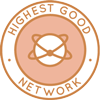 One Community is applying cooperative human relationships through open source Highest Good Network® software that is a web-based application for collaboration, time tracking, and objective data collection. The purpose of the Highest Good Network is to provide software for internal operations and external cooperation. It is being designed for global use in support of the different countries and communities replicating the One Community sustainable village models and related components.
One Community is applying cooperative human relationships through open source Highest Good Network® software that is a web-based application for collaboration, time tracking, and objective data collection. The purpose of the Highest Good Network is to provide software for internal operations and external cooperation. It is being designed for global use in support of the different countries and communities replicating the One Community sustainable village models and related components.
- Learn about this open source community collaboration and management software: The Highest Good Network
This week, the core team continued their work on the Highest Good Network PRs testing. This included confirming the fixed PRs, including a new method for tracking people who are followed up with About deadlines (PR#935+419), addition of middle name searching in the project member Search bar (PR#2022+786), resolution of a white screen issue when returning to the Dashboard from the Reports page (PR#2288), and ensuring that the details for a person viewed by clicking on their dot on the map are now displayed in Dark Mode (PR#2294). They also verified that creating a new role without a required role name and permissions is now handled gracefully in the UI (PR#2031), and fixed an issue where deleting a team member did not prompt a confirmation popup but only showed a deletion confirmation message from the HGN application (PR#2302). The PRs which were not fixed included the addition of a scheduled-on date to the scheduled blue square reason (FE2009/BE779) where no blue square was generated on the time off request, the creation of the ability for users to approve and apply suggested changes on a task (PR#1458), and a map bug where a deleted account is still shown and the number of team countries is incorrect. Additionally, they reported that the newly created role is not showing in the list of users roles. See the Highest Good Society and Highest Good Network pages for more on how this relates to applying cooperative human relationships. The collage below shows some of their work.
ALPHA SOFTWARE DEVELOPMENT TEAM
This week, the Alpha Team’s summary, covering their work on the Highest Good Network software was managed by Sucheta Mukherjee (Software Developer) and includes Anand Seshadri (Software Engineer), Jordy Corporan (Software Engineer) and Nathalia Carnevalli (Full Stack Software Developer). The Highest Good Network software is how we will manage and objectively measure our processes for applying cooperative human relationships across our social architecture, construction, production, and maintenance processes. This week, Jordy expanded his proficiency in unit testing, focusing on Jest while developing tests for the emailController. He aimed to refine his understanding and more effective unit tests, ensuring that all functions in the emailController were tested. Jordy also reviewed PR#962 and provided feedback. Anand did his part demonstrating applying cooperative human relationships as he worked on the Dark Mode Modals change in the Reports page and began developing a new feature to validate the Date field in the Add Task Modal. He tested PRs 2284 and 2308, identifying an issue with incorrect error handling in the date fields. For the new feature, Anand added state reset logic within a useEffect hook to reset the startedDate and dueDate fields to the current date and clear error messages whenever the Add Task modal is closed and reopened. He ensured date picker values were formatted using dateFnsFormat for display purposes, with the remaining task to perform a final test and raise a PR. Anand addressed all requested features and observed issues in the Dark Mode feature in the Report page modals, including adding a dark mode theme to the date picker, fixing the Info modal close button and heading alignment, and modularizing the code by centralizing fontColor and boxStyling logic. Nathalia did her part demonstrating applying cooperative human relationships as she started developing the edit functionality for the “i” popup on the weekly summaries report page, a feature accessible to owner-level users, and submitted her first pull request for the development branch. She reviewed and approved PRs #2295 and #2296+964 without finding any errors and is working on resolving some issues with another task.
Sucheta focused on implementing changes requested by PR reviewers, creating PR 2312 to develop a search function based on users’ first and last names, as well as an alphabetic search. An on-change event on an input field now provides users with a list of suggested usernames to choose from, generated by filtering the available user profiles in the state. If a user does not have a project assigned, a message will appear indicating the unavailability of the user or project. PR 2308 was recreated to fix the AddTaskModal format. PR 2313 was created as a hotfix to address error messages related to hours in the merged PR and fixed dark mode issues for several label tags in the modal. Additionally, PR 2301 was tested and approved as the feature worked as intended. See the Highest Good Society and Highest Good Network pages for more on how this relates to applying cooperative human relationships. View some of the team’s work in the collage below.
BADGES BUGS SOFTWARE DEVELOPMENT TEAM
The Badges Bugs Team’s summary overseeing advancements in the Highest Good Network software was managed by Shaofeng Li (Software Engineer) and includes Summit Kaushal (Backend Software Developer) and Xiao Zhang (Software Engineer) The Highest Good Network software is how we’ll be managing and objectively measuring our process for applying cooperative human relationships through our social architecture, construction, production, and maintenance processes. This week, Shaofeng completed various tasks as part of his role in the HGN Software Development project. On Tuesday, he held a one-on-one meeting with Xiao to discuss the latest project updates. By Thursday, he followed up on another team member’s progress through a personal discussion with Summit. On Friday, Shaofeng did two significant tasks: testing the functionality of awarding ‘xhoursin1week’ badges in the ‘xhoursxweeks’ components and leading the weekly team meeting to review the progress of all team members. Summit focused on debugging the unit test for PR 665, which was experiencing a forced exit before completion. Initial investigation pointed to a setInterval call in emailSender.js, prompting attempts to resolve the issue by adding checks and modifying the code. Further testing revealed that the problem might not be with the setInterval, but rather with the xhoursinxweeks function. Specifically, the function was returning an incorrect badge collection length, indicating a duplication issue within the badge count. Summit continued efforts towards testing and debugging the xhoursinxweeks logic to identify the root cause of the error. Xiao assumed additional responsibilities from a part-time colleague, concentrating on the thorough testing of all badges in the system to ensure their proper functioning and accuracy. He also committed time to troubleshooting and resolving any issues found, making sure all badges comply with the established standards. Alongside his testing tasks, Xiao delved into several functionalities of Microsoft Azure. His investigation focused on various techniques to improve database management practices. See the Highest Good Society and Highest Good Network pages for more on how this relates to applying cooperative human relationships. View some of the team’s work in the collage below.
BINARY BRIGADE SOFTWARE DEVELOPMENT TEAM
The Binary Brigade Team’s summary overseeing advancements in the Highest Good Network software was managed by Tapan Pathak (Software Engineer) and includes Aaryaneil Nimbalkar (Software Developer), Huijie Liu (Software Engineer) and Min Sun (Software Engineer). The Highest Good Network software is how we’ll be managing and objectively measuring our process for applying cooperative human relationships through our social architecture, construction, production, and maintenance processes. This week, Aaryaneil focused on adding unit tests to the Project Table component to test dark mode functionality. Additionally, he fixed issues in the VolunteeringTimeTab component based on PR reviews, and added test cases to check dark mode functionality for the ViewTab component. Unit test PRs 971, 973, 962, 954, and 2297 were tested, and PRs 2295, which addressed dark mode in modals on the user profile page, and 2311, which focused on dark mode hover functionality, were tested and reviewed. Huijie developed a strategy for updating the database and instructing team members on testing once the pull request for this task is submitted. She discussed and confirmed various details of this strategy in a video response.
Additionally, Huijie prepared to join the task of adding key Weekly Summary components to the overview report page and is currently reviewing the relevant documentation and Figma files. Min worked on task 717, which involved adding manager icons to the Tasks Tab. The task included placing a Google Doc icon next to the hours committed icon and adding Mentor, Manager, and Assistant Manager icons for each person below them. These icons are designed to navigate to the respective user profile pages upon clicking. Min added the Google icon next to the hours committed icon, enabling users to navigate to their Google link. Min also worked on implementing the clickable Mentor, Manager, and Assistant Manager icons for each person. Min did his part demonstrating applying cooperative human relationships as he approved PR 971 and 973. Tapan reviewed teammates’ previous week summaries, time logs, photos, and videos, providing feedback on their work and completing all managerial tasks. He scheduled the weekly meeting with the team, gathering updates and ensuring they had necessary resources. Tapan raised an issue in the coding problem channel regarding some local environment problems and received responses and solutions from colleagues. With their help, he continued working on the problem, created extra functions in the code, and ultimately fixed the issue, raising a PR. See the Highest Good Society and Highest Good Network pages for more on how this relates to applying cooperative human relationships. View some of the team’s work in the collage below.
BLUE STEEL SOFTWARE DEVELOPMENT TEAM
The Blue Steel Team’s summary, presenting their work on the Highest Good Network software was managed by Jingyi Jia (Software Engineer, Team Manager), and includes Bhuvan Dama (Full stack Developer), Imran Issa (Software Developer), Jay Srinivasan (Software Engineer), Parth Rasu Jangid (Software Developer), Ramakrishna Aruva (Software Engineer), Tzu Ning “Leo” Chueh (Software Engineer), and Xiao Wang (Software Engineer). The Highest Good Network software is how we’ll be managing and objectively measuring our process for applying cooperative human relationships through our social architecture, construction, production, and maintenance processes. This week, Xiao made PR2303, a hotfix that addresses the disappearance of the deletion icon for authorized users when viewing others’ time entries, continued work on the project component refactor, implemented project archive functionality, and addressed the white issue bug, with the task of resolving the white screen issue caused by removing a user from project resources by an admin role. Ramakrishna worked on the 5-letter team code search functionality, resolved a 500 error during an API call related to a MongoDB issue, fixed the root cause of the search options problem, tested his changes, raised a pull request, and began work on another task involving updates to the backend to accept numeric characters in the 5-letter team code. Jay did his part demonstrating applying cooperative human relationships as he started manager-in-training duties, completed unit tests for SetUpFinalDayButton.jsx achieving 100% code coverage, submitted a pull request, and claimed a new bug ticket to fix color discrepancies on pie charts for people reports. Bhuvan focused on various tasks in HGN Software Development, finalized test cases for TableFilter.js, resolved branch issues in Git that prevented project builds, and worked on test case and coverage issues for TableFilter.js.
Imran addressed requested changes for a previously opened PR, made frontend and backend changes to reduce redundancies and separate concerns, and made improvements in performance and code quality. Jingyi did her part demonstrating applying cooperative human relationships as she focused on developing the “editHeaderMessage” permission management feature and completed the frontend component by introducing a new permission item “editHeaderMessage”. Parth reviewed several pull requests, began writing unit tests for the TimeOffRequest Controller, and worked on integrating Ethereal Email for testing the email sender module. Tzu Ning focused on resolving issues related to the TinyMCE editor, corrected script paths, adjusted the Webpack configuration to handle process.env variables properly, implemented console logs. and utilized React DevTools to ensure the editor initialized without issues. See the Highest Good Society and Highest Good Network pages to learn more on how this relates to applying cooperative human relationships. See below to view images of their work.
CODE CRAFTERS SOFTWARE DEVELOPMENT TEAM
The Code Crafters Team’s summary, covering their work on the Highest Good Network software, was managed by Anirudh Ghildiyal (Software Engineer) and includes Anirudh Dutt (Software Engineer), Carlos Gomez (Full-stack Software Developer), Meet Padhiar (Software Engineer), Weiyao Li (Software Engineer) and Xiaoyu Chen (Software Engineer). The Highest Good Network software is how we’ll manage and objectively measure our process for applying cooperative human relationships through our social architecture, construction, production, and maintenance processes. Anirudh D focused on two primary tasks: unit tests for the taskNotificationController and resolving and updating his previous pull request related to creating permission constants, facing significant version control issues, particularly with merge conflicts and a time zone issue. Anirudh G worked on the DeleteModal and Timelog unit test cases, ensuring testing and preparing for a final review before raising a pull request. He also finished the weekly standup meeting, resolving teammate issues, gathering updates, and facilitating connections for problem-solving.
Carlos examined the Redux system, reducers, actions, and selectors, explored API calls to retrieve user project data, and ultimately created the action getTimeEntryByProjectSpecifiedPeriod to fetch data for the PiechartByProject component, leading to the development of PiechartByProject.jsx and the refactoring of WbsPieChart.jsx, followed by submitting pull requests to the codebase. Meet reviewed numerous pull requests related to UI changes and unit tests, finished functional testing of merged pull requests, and ensured adherence to best practices and application operation. Weiyao did her part demonstrating applying cooperative human relationships as she worked on the “add roles” feature, requiring edit access for permissions, and communicated with Jae for pretesting while also learning React, Redux, and testing concepts for future features. Xiaoyu developed integration tests for the rolePreset Router, updated a pull request, corrected previous issues with a hotfix, changed the date format to d-m-yyyy across applications, completed integration testing for the rolePresetRouter, and finished unit testing for the MouseoverText Controller, finalizing all unit tests and preparing pull requests while awaiting feedback from Diego on the integration test for the MouseoverText Controller. See the Highest Good Society and Highest Good Network pages for more on how this relates to applying cooperative human relationships. The collage below shows some of this work.
DEV DYNASTY SOFTWARE DEVELOPMENT TEAM
The Dev Dynasty Team’s summary, covering their work on the Highest Good Network software, was managed by Nahiyan Ahmed (Full Stack Software Developer) and includes Kaushik Malikireddy (Full Stack Developer Intern), Mingqian Chen (Software Engineer) and Harsh Bodgal (Software Engineer). The Highest Good Network software is how we’ll manage and objectively measure our process for applying cooperative human relationships through our social architecture, construction, production, and maintenance processes. Harsh focused on developing the Volunteer Summary Report component, setting up two team meetings to discuss designs, implementing them in Figma, gathering feedback from Jae, and starting work on the component using D3.js and React and a prototype for the Pie Chart Component. Kaushik did his part demonstrating applying cooperative human relationships as he integrated the GEMINI AI API with the HGN application to fetch weekly time logs and generate summaries for weekly submissions, enabling natural language processing tasks such as text completion and summarization. He also reviewed and approved three pull requests, resolved GitHub issues restricting his commits. Mingqian continued to enhance the delete function for the complete removal of individuals, finished testing by assigning and deleting volunteer accounts from various projects, and examined persistent WBS references, reviewing specific code files such as userManagement.js, userProfile.js, userProjects.js, and projectMembers.js to address the issue.
Nahiyan submitted four pull requests, including two small fixes: PR #2294, which added a new background color to user popups in the team locations map, and PR #2302, which replaced the old browser alert system with a new modal for message display. His significant pull requests included PR #2295, which implemented dark mode for all models within the user profile page along with minor adjustments, and PR #2311, which introduced a new hover effect for all tables in dark mode across the website and included additional minor fixes. See the Highest Good Society and Highest Good Network pages for more on how this relates to applying cooperative human relationships. The collage below shows some of this work.
EXPRESSERS SOFTWARE DEVELOPMENT TEAM
The Expressers Team’s summary, covering their work on the Highest Good Network software, was managed by Shereen Punnassery (Full Stack Software Engineer) and includes Christy Guo (Software Engineer), Ilya Flaks (Software Engineer), KyoSook Shin (Software Engineer) and Mohammad Abbas (Software Engineer). The Highest Good Network software is how we’ll be applying cooperative human relationships throughout our social architecture, construction, production, and maintenance processes. This week, Christy worked on the “Hours by Task” visualization, integrating D3 with other frontend components and updating the chart style for design coherence. Ilya completed the tools log task, refining the front-end logic by eliminating nested loops and enhancing error handling. He initiated new Pull Requests, #2296 for the front end and #964 for the back end, and provided technical support to teammates Christy, Kyo, and Shereen, concluding his contributions with One Community.
KyoSook did her part demonstrating applying cooperative human relationships as she reviewed the HGN Phase II document to identify development items, discovering the missing bmdashboard/equipment function was already being developed by another team member. She identified and started working on the time logger function, creating ‘kyo_bm_time_logger_fe’ and ‘kyo_bm_time_logger_be’ branches, adding the BMTimeLogger folder with BMTimeLogCard.jsx and BMTimeLogger.jsx files, and updating routes.js. Errors encountered while rendering these files will need to be resolved. Mohammad completed reviews for PRs #2298, #2300, and #2301, and planned to complete additional PR reviews on Saturday. Shereen updated the add tool component to integrate with the Redux store and implemented API calls for data synchronization between the front end and back end. She introduced Joi validation for the Add Tool form and created pull requests for both the front end and back end, ensuring data integrity and reliability. See the Highest Good Society and Highest Good Network pages for more on how this relates to applying cooperative human relationships. See the collage below for the team’s work this week.
GIT-R-DONE SOFTWARE DEVELOPMENT TEAM
The Git-R-Done Team’s summary, covering their work on the Highest Good Network software, was managed by Hiral Soni (Full Stack Developer) and includes Chris Chen (Software Engineer Intern), Malav Patel (Software Developer), Rhea Wu (Software Engineer), and Sushmitha Prathap (Software Developer). The Highest Good Network software is how we’ll be managing and objectively measuring our process for applying cooperative human relationships across our social architecture, construction, production, and maintenance processes. This week, Chris optimized the TotalProjectReport and TotalTeamReport components in the Highest Network Goods application for faster loading with PR #2298 and enhanced the Weekly Summaries Report with a spinning wheel indicator for data retrieval, improving user interactions across reports. Hiral worked on PR #2016, reviewing the code and making necessary changes, and added pagination functionality to the weekly summary page, which reduced the page’s execution time and improved its performance.
Malav worked on fixing bugs in the DELETE_TIME_ENTRY_OTHERS feature and HGN software development, made changes to restrict volunteer permissions for deleting owners/admins/managers’ Time Entry Logs, and is preparing to raise a PR. Rhea tested the building task, updated the codebase by modifying the route’s endpoint for the Issue router, and watched tutorials and read articles to enhance her knowledge. She began a new task, 9.2.4 Routing and Controllers for the Log Equipment form. Sushmitha did her part demonstrating applying cooperative human relationships as she fixed the remaining errors in all functions within the project Controller, completed formatting before creating the Pull Request, and resolved an issue with the husky code pre-commit with Diego’s assistance. She submitted the PR, which is now awaiting review, and watched videos on integration testing, addressed comments on the PR, made necessary changes, and worked on the weekly summary. See the Highest Good Society and Highest Good Network pages for more on how this relates to applying cooperative human relationships. See the collage below for the team’s work this week.
MOONFALL’S SOFTWARE DEVELOPMENT TEAM
Moonfall Team’s summary, covering their work on the Highest Good Network software, was managed by Lu Wang (Software Engineer) and includes Abdelmounaim “Abdel” Lallouache (Software Developer) and Jiadong Zhang (Software Engineer). The Highest Good Network software is how we’ll be managing and objectively measuring our process for applying cooperative human relationships throughout our social architecture, construction, production, and maintenance processes. Abdelmounaim continued developing a solution for assigning recipients of the blue square emails. He completed the backend, tested the endpoints, and on the frontend, created the modal layout and added the reducer, action creators, and thunk function to facilitate API calls to the backend. Jiadong focused on replacing the badge on the dashboard and debugging the frontend. During this process, he identified issues with badge management, merged the most recent updates from the main branch, and made necessary changes to ensure the feature functioned correctly.
Lu concentrated on rewriting the code and fixing bugs in the unit tests. In the testing phase, she rewrote the selector functions, chart functions, and other related components. Additionally, she was responsible for assistant team management, which included writing the weekly report and reviewing teammates’ work. See the Highest Good Society and Highest Good Network pages for more on how this relates to applying cooperative human relationships. Look below for a collage of their work.
REACTONAUTS’ SOFTWARE DEVELOPMENT TEAM
Reactonauts’ Team’s summary, covering their work on the Highest Good Network software, was managed by Xiaolai Li (Administrative Assistant) and includes Changhao Li (Software Engineer), Dhairya Mehta (Software Engineer), Peterson Rodrigues (Full-Stack MERN Stack Developer), Shengwei Peng (Software Engineer), Shiwani Rajagopalan (Software Engineer) and Vikram Badhan (Software Engineer). The Highest Good Network software is how we’ll be managing and objectively measuring our process for applying cooperative human relationships throughout our social architecture, construction, production, and maintenance processes. Changhao worked on solving multiple PR issues, created the team picture folder, and handled other team management tasks. He resolved a merge issue caused by changes in the development branch. Additionally, Changhao addressed previous merge conflicts, and the PRs are now ready for review and merge.
Dhairya focused on addressing the “Fix Projects find user function” task, he identified the root cause of the issue affecting user discovery within the projects section. He also developed a sort and search function. Peterson fixed a bug in the “Tasks Contributed” section of the People Report. After the fix, only the blue buttons are displayed if the user has no tasks; if the user has tasks, the table will also be displayed. Shengwei did his part demonstrating applying cooperative human relationships as he worked on two different tasks. The first involved adding a new implementation in the backend to protect the admin account. The second task is related to the memory leaking issue in the user profile page.
Shiwani worked on the TeamReport unit test, creating 16 detailed test cases. She verified that the component renders properly, using a mock Redux store and a match prop. She then validated the display of team details when a team is available. For the Active and Inactive checkboxes, Shiwani selected them by their IDs, confirmed they were initially unchecked, and simulated clicks to ensure they became checked. Vikram developed and executed various test cases to ensure the components’ functionality and reliability. His work included writing test scripts, debugging issues, and refining the codebase to improve performance and stability. See the Highest Good Society and Highest Good Network pages for more on how this relates to applying cooperative human relationships. Look below for pictures of this work.
SKYE’S SOFTWARE DEVELOPMENT TEAM
Skye’s summary, covering their work on the Highest Good Network software, was managed by Luis Arevalo (Front End Developer) and includes Abi Liu (Software Engineer), Bhuvaneswari Gnanasekar (Software Engineer), Clemar Nunes (Web Developer), Gowtham Dongari (Software Engineer) and Jiarong Li (Software Engineer). The Highest Good Network software is how we’ll be managing and objectively measuring our process for applying cooperative human relationships throughout our social architecture, construction, production, and maintenance processes. Abi set up integration tests for the mapLocations routes and initiated tests for the getAllLocations, and deleteLocation routes. Additionally, there was a meeting with Harsh to discuss tasks and specifications required for the new weekly summary reporting page, including exploring modifications to existing APIs to better align with new requirements. Bhuvaneswari worked on the task of sending an email when a user account is deactivated from the system. Updates were made to the API (SendDeactivationEmail) and the Router file.
Clemar focused on final testing and verification processes of the task at hand, ensuring the quality and integrity of the code. He also implemented a modal prompt advising users to log out and log back in. Gowtham did his part demonstrating applying cooperative human relationships as he resolved merge conflicts associated with the team location search error, ensuring that his solutions were integrated into the main project without disrupting existing features. In addition, Gowtham addressed an error related to null values in the tangible time displayed on the leaderboard. He also worked on improving the rendering of links in the leaderboard on the dashboard page, focusing on user experience and interaction. Luis worked on unit testing the inventoryController and completed testing the postInvInProjectWBS function and the getAllInvInProject function. Jiarong’s focus was on addressing an issue that required rolling back the code using git, which was found to originate from the backend. See the Highest Good Society and Highest Good Network pages for more on how this relates to applying cooperative human relationships. See the collage below for some of their work.
SOFTWARE PR REVIEW TEAM A-L
The PR Review Team’s summaries for team members’ names starting with A-L and covering their work on the Highest Good Network software was managed by Vibhav Chimatapu (Data Analyst/Admin Assistant). The Highest Good Network software is a foundation of what we’ll be using to measure our results for applying cooperative human relationships. This week’s active members of this team were: Carl Bebli (Software Engineer), Chunyun Zhang (Software Engineer), Deepthi Kannan (Software Engineer), Dikshita Kejriwal (Software Engineer), Hui Kong (Software Engineer), Jatin Agrawal (Software Engineer), Jiayu Huang (Software Engineer), Jin Hu (Volunteer Software Engineer), Jinxiong You (Software Engineer), Kavil Rajendra Jain (Volunteer Software Engineer), Kurtis Ivey (Software Engineer), Kyrene Flores (Software Engineer) and Logeshwari Renu (Software Engineer). They reviewed all the Highest Good Network PRs (Pull Requests) shared in this week’s update. Learn more about how the Highest Good Network will measure and assist in applying cooperative human relationships in the Highest Good Network open source hub. The collage below shows a compilation of the work from this team.
SOFTWARE PR REVIEW TEAM M-Z
The PR Review Team’s summary for team members’ names starting with M-Z and covering their work on the Highest Good Network software was managed by Olawunmi Ijisesan (Administrative and Management Support) and Samarth Urs (Administrative Assistant and Data Analyst). The Highest Good Network software is a foundation of what we’ll be using to measure our results of applying cooperative human relationships. This week’s active members of this team were: Nathan Hoffman (Software Engineer), Olga Yudkin (Software Engineer), Peizhou Zhang (Software Engineer), Ramya Ramasamy (Full Stack Developer), Sandhya Adavikolanu (Software Developer), Tianyang Leng (Software Engineer), Vijeth Venkatesha (Full Stack Developer), Wenbo Liu (Software Engineer Volunteer) and Yiyun Tan (Software Engineer). They reviewed all the Highest Good Network PRs (Pull Requests) shared in this week’s update. Learn more about how the Highest Good Network will measure and assist in applying cooperative human relationships in the Highest Good Network open source hub. The collage below shows a compilation of the work from this team.
AND WE PRODUCED THIS WEEKLY UPDATES BLOG – CLICK HERE TO SUBSCRIBE
FOLLOW ONE COMMUNITY’S PROGRESS (click icons for our pages)
INVESTOR PAGES
GET INVOLVED
DONATE | WAYS ANYONE CAN HELP | MEMBERSHIP
CLICK HERE FOR ALL PAST UPDATES
Category: Basics of One Community, Community, One Community Tags: creating a new world paradigm, open source, grass roots sustainability, open source food, the betterment of society, non profit, self-sufficiency, ecological living, creating holistic transformational change, sustainable living, radical sustainability, solutions that create solutions, regenerative world building, open source sustainability, open source housing, One Community progress, Duplicable City Center Hub, global sustainability, open source design, Education For Life progress, better is possible, for the highest good of all, Applying Cooperative Human Relationships, transforming the global environment, solution based thinking, sustainable community building, Earthbag Village, Highest Good education, one community, Permaculture Communities, Highest Good housing, food forest, green living, resource based economy, Highest Good food, sustainable civilization building, permaculture, RBE, Highest Good society, creating global solutions, One Community Update, addressing climate change, Education for Life update
WHO WE ARE
MAIN OPEN SOURCE HUBS
GET INVOLVED
SPECIFIC HELP
- Seeking Web Developers
- Seeking General Contractor
- Seeking Software Developers
- Seeking Master Electrician
- Seeking Food Specialists
- Seeking Master Plumber
- Seeking Educators, Parents & Creative Minds
- Seeking Civil Engineer
- Seeking Structural Engineer
- Seeking Permaculturalists
- Seeking Irrigation Specialists
- Seeking Surveyor
- Seeking Lawyers and Paralegals
- Seeking Videographer
- Seeking Graphic Designer
FOOD COMPONENTS
- OS Hub
- Grow
- Build
- Ethical, Humane, & Conscientious Goat Stewardship
- Ethical, Humane, & Conscientious Rabbit Stewardship
- Ethical, Humane, & Conscientious Chicken Stewardship
- Food Forest
- Hoop Houses
- Apiary/Bee Yard
- Botanical Garden Creation & Inventorying
- Conscientious Wildlife Stewardship and Habitat Development
- Large-scale Gardening
- Soil Amendment & Site Preparation
 One Community
One Community


